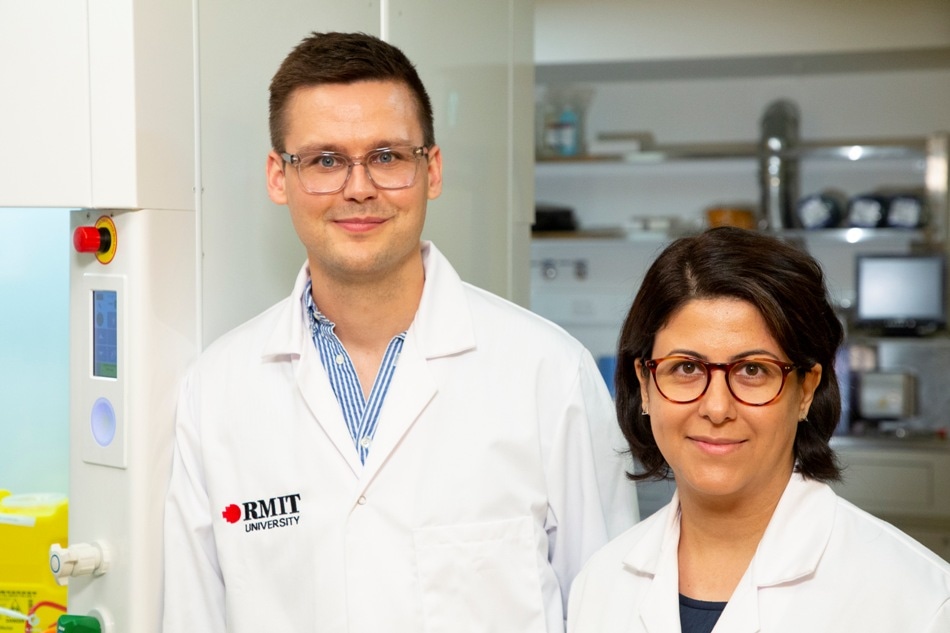Feb 27 2019
Scientists have converted carbon dioxide back into solid coal using liquid metals, in a first-ever ground-breaking discovery that could revolutionize the approach to carbon capture and storage.
 Australian Research Council DECRA Fellow Dr Torben Daeneke and Vice-Chancellor’s Research Fellow Dr Dorna Esrafilzadeh. (Image credit: RMIT University)
Australian Research Council DECRA Fellow Dr Torben Daeneke and Vice-Chancellor’s Research Fellow Dr Dorna Esrafilzadeh. (Image credit: RMIT University)
The team of researchers led by RMIT University in Melbourne, Australia, has devised a new method that can efficiently turn gaseous CO2 into solid carbon particles.
The work is reported in the journal Nature Communications and provides an alternative approach to remove the greenhouse gas safely and permanently from the earth’s atmosphere.
Existing technologies for carbon capture and storage involve reducing CO2 into a liquid form, transporting it to an appropriate site, and injecting it underground.
However, execution of such technologies has been hindered by problems around economic feasibility, engineering challenges, and environmental concerns regarding possible leaks from the storage sites.
Dr Torben Daeneke, an RMIT researcher, stated that turning CO2 into a solid could be a more sustainable method.
While we can’t literally turn back time, turning carbon dioxide back into coal and burying it back in the ground is a bit like rewinding the emissions clock. To date, CO2 has only been converted into a solid at extremely high temperatures, making it industrially unviable. By using liquid metals as a catalyst, we’ve shown it’s possible to turn the gas back into carbon at room temperature, in a process that’s efficient and scalable. While more research needs to be done, it’s a crucial first step to delivering solid storage of carbon.
Dr Torben Daeneke, Australian Research Council DECRA Fellow and Researcher, RMIT.
How the Carbon Conversion Works
The electrochemical method to capture and transform atmospheric CO2 into storable solid carbon was developed by Dr Dorna Esrafilzadeh, lead author and a Vice-Chancellor’s Research Fellow in RMIT’s School of Engineering.
In order to convert CO2, the scientists created a liquid metal catalyst with particular surface properties that caused it to be very efficient at conducting electricity while chemically activating the surface.
The carbon dioxide is dissolved in a beaker containing an electrolyte liquid and a small quantity of the liquid metal, which is subsequently charged with an electrical current.
The CO2 gradually turns into solid flakes of carbon, which are physically separated from the liquid metal surface, enabling the continuous production of carbonaceous solid.
Esrafilzadeh stated that the carbon formed could also be used as an electrode.
A side benefit of the process is that the carbon can hold electrical charge, becoming a supercapacitor, so it could potentially be used as a component in future vehicles. The process also produces synthetic fuel as a by-product, which could also have industrial applications.
Dr Dorna Esrafilzadeh, Study Lead Author and Vice-Chancellor’s Research Fellow, RMIT.
The study was carried out at RMIT’s MicroNano Research Facility and the RMIT Microscopy and Microanalysis Facility, with the lead investigator, Honorary RMIT, and ARC Laureate Fellow, Professor Kourosh Kalantar-Zadeh (now UNSW).
The Australian Research Council Centre for Future Low-Energy Electronics Technologies (FLEET) and the ARC Centre of Excellence for Electromaterials Science (ACES) supported the work.
The partnership included researchers from Germany (University of Munster), China (Nanjing University of Aeronautics and Astronautics), the United States (North Carolina State University), and Australia (UNSW, University of Wollongong, Monash University, QUT).
The study has been published in Nature Communications (“Room temperature CO2 reduction to solid carbon species on liquid metals featuring atomically thin ceria interfaces”).
Turning carbon dioxide back into coal | RMIT University
Scientists have used liquid metals to turn carbon dioxide back into solid coal, a breakthrough that could transform our approach to carbon capture and storage. (Video credit: RMIT University)